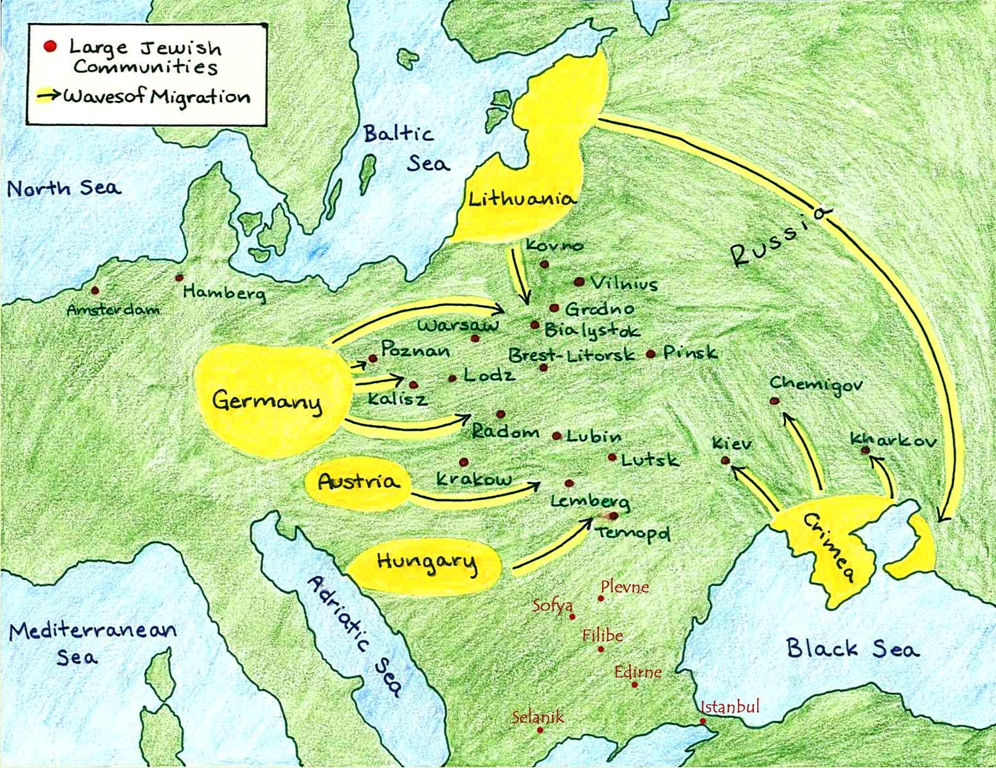Ashkenazim, from the Ottoman Empire to the Turkish Republic
The word “Ashkenazi” has been used to describe German territories since the Middle Ages and in time, has begun to refer to all Eastern European Jews. Ashkenazim living in Turkey are the descendants of people who emigrated to the Ottoman Empire from Eastern European countries at various times.
First evidence of an organized Ashkenazi community is from about 1250 after the deportation of Jews from France and Hungary. The Ashkeanzim then lived alongside the Ramaniyot Jews who lived in these lands.
The first known contact of the Ottomans with Ashkenazim was during the first territorial expansion process before the Empire. Ashkenazim were among the first settlers in the region, while the Ottomans expanded their territories in the 14th century. There was also an Ashkenazi community in Izmir. As we understand, from the famous letter of the Ashkenazi Rabbi Isaac Tzarfati who invited German, Hungarian and French Jews to the Ottoman lands in the mid-15th century, the community was satisfied with this settlement, which would extend to hundreds of years.
During the forced migration of 1492, the Ashkenazim from the Central and Eastern European countries set out for the Ottoman lands, along with the Sephardi Jews escaping from the Iberian Peninsula. Sofia, Plovdiv, Thessaloniki, Pleven and Istanbul were the major cities where Ashkenazim settled and established their own synagogues. This wave of migration was followed by groups of people coming from today’s Serbia and Hungary. These Ashkenazim, who accepted the Sultan’s famous Ferman de los Alemanes invitation, settled mainly in Istanbul, Edirne, Salonica and Palestine.
 By the 17th century, Ashkenazim, under the roof of the Ottoman Empire, started to host new immigrant groups coming from Europe, and even enjoyed prosperity and self-confidence up to buy slaves from the captive markets and free them. Two centuries later, the impact of the Ottoman-Russian Wars led to the migration of new families to Istanbul from Russian territories and the Black Sea Basin.
By the 17th century, Ashkenazim, under the roof of the Ottoman Empire, started to host new immigrant groups coming from Europe, and even enjoyed prosperity and self-confidence up to buy slaves from the captive markets and free them. Two centuries later, the impact of the Ottoman-Russian Wars led to the migration of new families to Istanbul from Russian territories and the Black Sea Basin.
The second half of the 19th century was a period when the Ashkenazim took on major roles in the political and commercial relations between the Austro-Hungarian Empire and the Ottomans. Ashkenazim from Europe have taken over high-level executive positions especially in financial, educational and cultural institutions based in the Galata region, and started to create an elite social environment thanks to their modern lifestyles and cultural background.
This social and economic differentiation, while preparing the ground for the emergence of Ashkenazim’s cultural establishments, did not prevent them from making endeavors for the cultural development of their coreligionists.
By the time the Empire came to an end and a new country was established, the Turkish Ashkenazim were a community affiliated to the Chief Rabbinate as a congregation based in Galata. During the Republican era, which is close to its centenary, they continued to play important roles in many areas of the social life from free trade to art, from education to science, and kept on enriching our cultural heritage.
In the course of hundreds of years, Ashkenazim (who were sometimes called vuzvuz1 or Lehli2) have brought their memories, their experiences and their cultural identities from the regions they came from. This exhibition aims to present the story of a culture, that came from dozens of geographies and blended in these very lands.
1 Vuz means “what?” in Yiddish.
2 Lehli means Polish.













